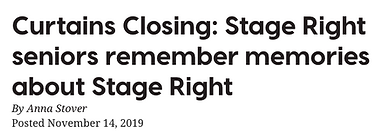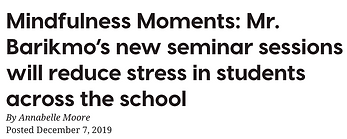EDITING
Editing is one of the tasks I spend the most time on without officially acknowledging it. Whether it's a headline on the website or a story needing a structural rewrite, I go through a process that focuses on optimizing the body of work's potential and emphasizes the importance of professionalism.
It's also about the things that whomever I'm editing (and I) take away, like valuable experience in giving and receiving constructive criticism and how to
best articulate where a story struggles or succeeds through edits.
Here's a look into my editing process that I use on other staffers' stories and my own.
The Word Cemetery
I certainly didn’t come up with the word cemetery — that credit goes to Lori Oglesbee, a teacher I had at the 2018 NSPA Gloria Shields Workshop in Dallas, TX. But this feature is something I use religiously, both in my stories and others that I'm editing.
Anytime I'm editing, the first thing I do is move the story through the word cemetery — a collection of words that could easily be removed and replaced with more descriptive, clear ones. Traditionally, I write with a lot of words on this list, but one trip through the cemetery can make a huge difference in any type of story.

Here's a spot news draft before and after I ran it through the word cemetery. The story smoothens itself out with active, not passive voice. Using the list has become a central jump point of my editing process.
THE SELF-EDITING PROCESS
I treat each of my own stories the most harshly when I’m editing. By the time I’m seeking edits from copy editors, I’ve already gone through at least two edits, and most of my finalized stories have been through three or four drafts.
It's always important to critique everything — the story can always be better, and as easy as it is for me to overlook (especially when it's your own story), I always edit my story through a clear and unaltered lens.
Below, you'll see edits I made on my own story. The one on the left was on its third draft by that point, and after self-editing again, I realized some structural changes needed to be made and the focus needed a shift. The final draft is on the right.
After editing this, my third draft, I realized my problem wasn't the way the story was written — it was how it was organized. Auggie had far too complex of a story to cover in a boxed feature about spreading positivity.
I bared this in mind as I restructured it. I knew if I split the story up into parts, each part would likely stand on its own as a story.
By the time I found what I considered to be the ideal structure, it was evident that the story wasn't just going to be switched around. Like many stories I've written, the fourth draft needed to go in an entirely new direction.
Scroll down the document to see the annotations.
After I rewrote and restructured, the story went from just over 1000 words to about 2900. But the content was a longplaying study into how Auggie became Auggie, and how he really always was but didn't have the environment to embrace it.
Focus changes like these come a lot in stories, and it's just as important to point them out and fix them in others' stories as it is your own.
I'm always sure to be at least content with the story before seeking edits from copy editors on it — but to be content, I'll have to edit it myself a few times and work through a few drafts to work out the kinks I can see myself.
HEADLINE EDITING
Something I emphasize while working with other staffers as they're publishing stories online is the lack of attention span that readers should be assumed to have. To catch their attention, a grabbing, unique and to-the-point headline is needed.
Sometimes headlines won't offer some of those attributes — so my job, and what I spend much of my time on, is fixing them. Here are some examples of headlines I've edited of stories from The Harbinger.


The original headline here was repetitive and redundant. In keeping with our general style, I switched the headline to a teaser-teller and formatted the teller in a cleaner, more standard way (subject-verb-object).


Considering this story was focused on a statement made by Instagram — which is widely used by East students — regarding their new likes policy, the headline needed to be clean and to the point. So I scrapped the teller headline that was originally used by the writer and opted for the teller on the right. Since the day the policy would be effective wasn't known at the time, I left it as "sometime this week."


The original headline (left) was certainly editorialized in its assumation that the sessions would rid the school of stress, so I changed it to better fit the story's focus on the sessions' intentions and aspirations.


This headline was originally posted as only a teaser, leaving it vague and lacking any information for the reader to be compelled to read by. I added a teller that left the story ambiguous enough to offer potentially compelling uncertainty.
INTERVIEW QUESTIONS
I prefer to enter my interviews with a notepad, pen and two recorders — not necessarily with a set of questions to stick to. I'm most effective with a list of bullet points to cover, allowing me to play off of the conversation to enter new topics pertinent to the story.
Many staffers, though, prefer to enter interviews with questions pre-written to ensure they're asked. In scenarios like this, I diagnose the story's intended focus and expand off of it to find the most important questions I can, as simple as they can be asked, and get rid of redundant questions. Here's an example of that process.
The following set of interview questions is from a story written by a colleague about two high schoolers and their plans to travel the country in a van on a gap year. The interviews were meant to gather background information about the subjects from their close family members.
The interviews contain my suggestions with markups and reasoning.
This set of interview questions was properly structured and set up by my colleague, but the wording at times would've been rough in conversation.
Considering the interview was written out like this, I knew it would help to have the questions as close to verbatim for my colleague just in case.
This sequence of interview questions was much more well-structured and flowed more naturally than the previous set, but I still had critiques.
Sometimes, a few tweaked words in a question are all it takes to bring about an insightful answer — so I tried to inject personability in the questions wherever I could.